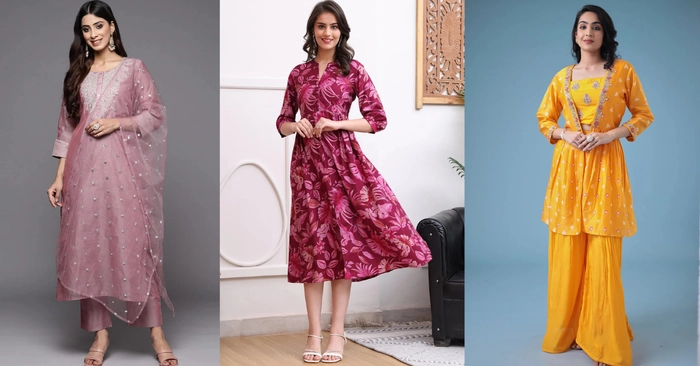Chanderi fabric has always been associated with luxury, grace and royal heritage. This beautiful fabric, hand woven in the town of Chanderi, Madhya Pradesh, India has been the pride of royals for years. Presently, Chanderi ethnic wear still continues to delight fashion lovers with its remarkable delicate texture, glittery allure, and intricate craftsmanship. Let's discover the magic of Chanderi fabric and how it has adapted to modern fashion needs while keeping its classic essence intact.
Chanderi's Rich Heritage
A Fabric Fit For Royalty
The remarkable history of Chanderi weaving goes as far back as the Vedic period. It is said that Lord Krishna’s cousin, Shishupala, was the weaver of this fabric. It gradually received recognition during the Mughal period and became popular among the elites for its gossamer texture and royal appeal. The exquisite combination of silk and cotton blended with zari (gold or silver thread) results in a soft and lightweight fabric that is ideal for the Indian subcontinent.
The Chanderi Weaving Art
Showcasing the splendor of Indian weavers, Chanderi fabric is created using skill and precision. It incorporates multiple processes right from preparing the thread to the final touch of embellishments, complete with intricate nature-inspired motifs and geometric patterns. Blossom artisans use traditional pit looms to weave and incorporate Mughali designs as well. The outcome is a labor-intensive art piece that serves as clothing.
Chanderi in Modern Fashion
Contemporary Designs with Chanderi
Endowed with a range of uses, the remarkably light fabric was initially meant only for sarees. Chanderi ethnic wear has evolved to include a host of other clothing such as kurtas, lehengas, dupattas, and even western-style dresses. Various designers have begun using chanderi in their creations and are adding contemporary cuts, which is making the fabric differentially available for the younger audience. While ensuring to keep the traditional essence, the fabric's adaptability puts it at the forefront of today's fashion world.
Eco-Friendly and Sustainable Fashion
Chanderi fabric has set its benchmark among other fabrics as an eco-friendly option. The process of weaving Chanderi on handlooms is energy efficient free from carbon emissions. Moreover, the impending use of natural fibers and dyes adds to the sustainable fashion goals. By choosing Chanderi ethnic wear, consumers not only embrace style but also support sustainable practices and traditional craftsmanship.
The Appeal of Chanderi Patterns
Modern Designs with an Age-Old Touch
Motifs incorporated as part of Chanderi fabric are perhaps among the most notable of its features. Florals, peacocks, coins, and other geometrical shapes are commonplace in traditional designs. Contemporary designers are adding modern twists to traditional designs, turning these well-known classics into new, bold masterpieces. Chanderi keeps on evolving and adapting in the modern world while making sure that its heritage and history are not forgotten.
Sparkling Elegance of Zari Work
Zari embroidery adds elegance to the Chanderi weave, making it more regal. It involves weaving gold and silver thread into shimmering shapes on the fabric. Apart from the beauty added to the fabric, the delicate metallic work enhances the royal touch the fabric brings. Modern zari work includes subtle infusions of sophisticated, minimalist designs for those who aspire for greater sophistication without attracting attention.
Long Lasting Beauty
Caring for Chanderi ethnic wear isn’t simple so doing it right can make the garments last long without losing their beauty. Rough handling, such as machine cleaning, is best avoided, as the intricate zari work gets tangled easily. Professional dry cleaning is most suitable for such garments, but if hand washing is preferred, a gentle cold wash will do. In the case of drying, avoid exposing the cloth directly to the air, as this may damage it. Instead, gently squeeze the fabric to remove excess water and lay it flat in the shade. Warding off direct sunlight works wonders for the Chanderi ethnic weave, helping prevent damage to their delicate weave while retaining their luster.
Chanderi Style for Diverse Occasions
How to Transition from Festivals to Casual Occasions
The Chanderi fabric styling is suitable for numerous occasions. While traditional Chanderi sarees are perfect for formal events and weddings because of their grace and charm, casual day-to-day looks can also be achieved using Chanderi kurtas paired with jeans or palazzos. The saree is layered and chic, while the fabric’s light weight nature means it can be worn all day without fussing, and it can be altered to suit different styles. Get creative with your wear and transition effortlessly from day to night.
Accessorizing Chanderi Outfits
Chanderi ethnic wear has beautiful designs interwoven into delicate fabrics. Because of this, preservation of these works of art becomes imperative, and often less is more when it comes to accessories. For more traditional attire, wearing a Chanderi saree or kurta can be paired with bold gold or silver statement fashion jewellery. A modern approach calls for wearing soft accessories that are equally eye-catching but do not compete with the gown.
To wrap things up, Chanderi ethnic wear is an exquisite union of tradition and modernity. It is cherished by many, especially in this age, because of its heritage and blend of contemporary designs. We at FabPotli value the grace of Chanderi fabric, which is why we showcase a handpicked selection of the most stunning pieces of this royal weave, designed with contemporary aesthetics. Whether you’re going to a wedding or in search of everyday sophistication, Chanderi ethnic wear is undoubtedly the ideal option for sustainable style, versatility, and elegance.

